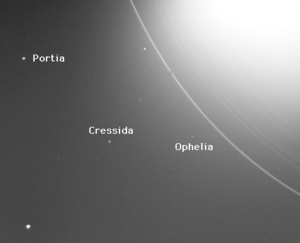Cressida (moon) facts for kids
| Discovery | |
|---|---|
| Discovered by | Stephen P. Synnott / Voyager 2 |
| Discovery date | January 9, 1986 |
| Orbital characteristics | |
|
Mean orbit radius
|
61,766.730 ± 0.046 km |
| Eccentricity | 0.00036 ± 0.00011 |
| 0.463569601 ± 0.000000013 d | |
| Inclination | 0.006 ± 0.040° (to Uranus' equator) |
| Satellite of | Uranus |
| Physical characteristics | |
| Dimensions | 92 × 74 × 74 km |
|
Mean radius
|
41 ± 2 km |
| ~20,000 km² | |
| Volume | ~260,000 km³ |
| Mass | ~3.4×1017 kg |
|
Mean density
|
~1.3 g/cm³ (assumed) |
| ~0.013 m/s2 | |
| ~0.034 km/s | |
| synchronous | |
| zero | |
| Albedo | 0.08 ± 0.01 |
| Temperature | ~64 K |
Cressida is one of the inner moons that orbit close to the planet Uranus. Scientists discovered Cressida using pictures taken by the Voyager 2 spacecraft. This discovery happened on 1986-01-09. When it was first found, it was called S/1986 U 3.
Later, this moon was named Cressida. This name comes from a character in old stories and a play by William Shakespeare called Troilus and Cressida. Cressida is also known as Uranus IX.
The Portia Group
Cressida is part of a group of moons known as the Portia Group. This group includes several other moons orbiting Uranus. Some of these moons are Bianca, Desdemona, Juliet, Portia, Rosalind, Cupid, Belinda, and Perdita.
These moons all travel around Uranus in very similar paths. They also reflect light in a similar way.
What We Know About Cressida
We do not know a lot about Cressida. We know its orbit around Uranus. We also know its size, which is about 41 km (25 miles) wide. Its surface reflects about 8% of the sunlight that hits it. This is called its geometric albedo.
Pictures from Voyager 2 show that Cressida is not perfectly round. It looks a bit stretched out, like a rugby ball. The longest part of its shape points directly towards Uranus. Its surface appears to be grey in color.
Images for kids
See also
 In Spanish: Crésida (satélite) para niños
In Spanish: Crésida (satélite) para niños



